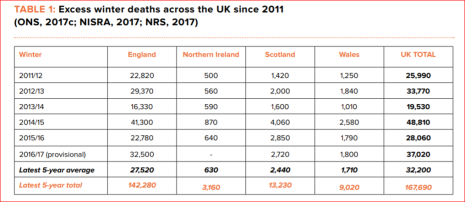“UK Fuel Poverty Monitor 2017-2018," fuelpovertyni.org
p. 3: “The table below shows the number of excess winter deaths in the UK from 2011 until the latest available data for last winter [2017-18]. Five-year totals and averages are shown encompassing the latest five years for which data is available.4″
.....

“The UK Fuel Poverty Monitor is the annual
investigative report on fuel Poverty in the UK and
within each of the four nations, published by National
Energy Action (NEA) and Energy Action Scotland
(EAS). Whilst the overlap between fuel poverty,
cold-related illness and premature mortality are not
entirely symmetrical, the Monitor has investigated
the key policies and practices that affect these
overlapping issues for many years and has made
country-specific and national recommendations.
Cold homes cause unnecessary death and suffering,
and it is not acceptable that thousands of people die as a
result of living in a home which is cold in one of the
richest countries in the world.”…
page 5: “Between 28th February and 3rd March 2018
the UK suffered some of the most severe winter weather
seen since 2010. Referred to in the media as “the
Beast from the East”, the freezing conditions saw
the Met Office issue two red warnings for snow,
and multiple amber warnings for snow and ice across
large swathes of the country. There was severe
travel disruption, with some cars stranded overnight on major routes.
Schools were closed across the country, and thousands of homes suffered power cuts.
Some rural communities were entirely cut off, and had to receive supplies by helicopter. Wind chill factors dropped as low as -10 °C, and some areas saw 50cm or more of snow. Daytime temperatures dropped as low as -4°C. Across the UK, February and March 2018 saw 101 Cold Weather Payment triggers (£25 automatically paid to eligible households when the average temperature has been recorded as, or is forecast to be, 0°C or below for seven consecutive days).
Many vulnerable households, however, were left stranded without access to support, adding to the already significant annual burden of excess winter mortality and morbidity across the population….
Simon Stevens, Chief Executive of NHS England, determined that February 2018 was the “most pressurised month the NHS has seen in its nearly 70-year history”9. Corridors were left crowded with people waiting for eight hours or more just to be seen and senior medical staff were seen to be in tears.10
The effects of the cold snap this winter were felt well into March 2018, placing further strains upon the health service.
In England alone, between 1st January and 31st March 2018, an additional 15,544 deaths occurred. This is 12% higher than the five year average (2013-2017). Most individual days in this period saw more deaths than the corresponding day in any of the previous five years11, 12. Deaths began to climb well above the five-year average during the cold spell and remained high for almost two weeks after (as seen in Fig 1 below). This reinforces current evidence that it can take several days after a cold spell for death rates to return to average levels.”…
………………………………
Added:
11/22/2012, “Cold homes costing NHS £1.36 billion,” ageuk.org
"Cold homes are costing the NHS in England £1.36 billion every year in hospital and primary care."
“Thousands of older people continue to die prematurely from cold-related illnesses because their homes are too cold. Each year there are around 27,000 excess winter deaths,(3) most of them among older people and caused by respiratory problems, strokes and heart-attacks due to cold temperatures.”…
[“3 The average figure for the past 10 years for England and Wales is 26,700. This figure is calculated by comparing deaths during the winter months (December to March) with deaths occurring at other times of the year. NEW figures for winter 2011-12 are due to be published by the Office of National Statistics on Thursday 29 November 2012.”]
(continuing): “Even in relatively mild winters, there are around 8,000 extra deaths for every one degree drop in average temperature(8)….People living in the coldest homes are three times as likely to die from a cold-related illness compared to those in warmer homes (9). The prevalence of poorly insulated homes (10) coupled with sharp increases in energy prices over recent years has exacerbated the UK’s growing fuel poverty problem, forcing many older people to cut back on their heating in a bid to control costs.
The new report argues that this scandal can be halted: other much colder countries such as Finland have significantly lower death rates than the UK largely due to better insulated homes and greater awareness of the importance of keeping warm….
Michelle Mitchell, Charity Director General at Age UK said: ‘It’s an absolute scandal that tens of thousands of older people will become ill or die this winter because they are unable to keep warm. Not only is this resulting in an incalculable human cost but the NHS is spending more than a billion pounds on treating the casualties of cold every year.
‘At the root of the problem are badly insulated homes, which together with cripplingly high energy prices, are leaving millions of older people having to choose between staying warm and energy bills they can afford. We are calling on all local authorities to recognise the issue as a major health priority and make sure they are doing everything within their power to keep older people warm.'”…
................

No comments:
Post a Comment